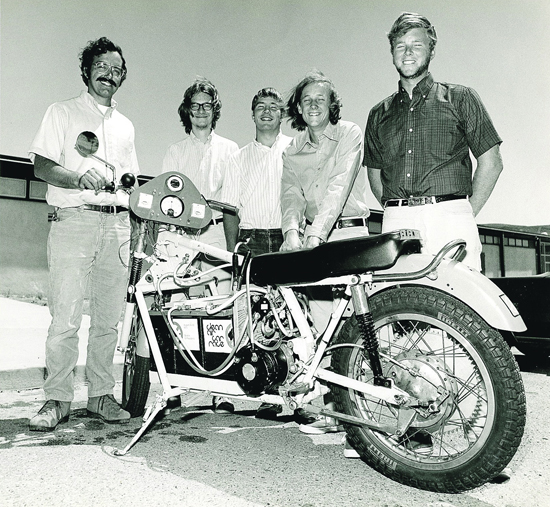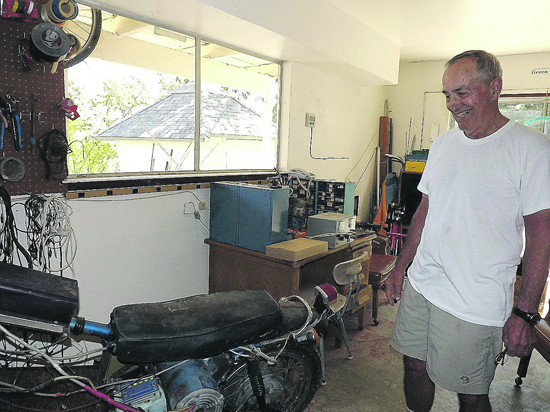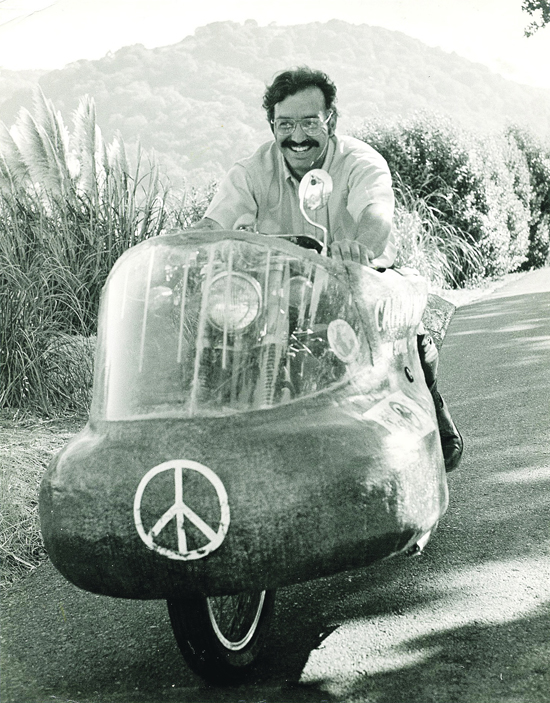| | Published August 29th, 2012
| Electric Ahead of their Time:
Campo Alums Remember 1970 Cross Country EV Race
| | Cathy Dausman |  | | The 1970 Clean Air Car Race crew, from left: teacher Tony de Bellis, Larry Rinehardt, John Muir, Charlie Wurm, Mark Schneider (Missing: Peter Clark). Courtesy Tony de Bellis |
Lamorinda parents in favor of having your high school son make a cross country summer trip on a motorcycle, please raise your hand!
 Don't worry - the permission slips aren't going out anytime soon. In fact, that trip, although definitely one for the books, was safely completed 40-plus years ago.
Don't worry - the permission slips aren't going out anytime soon. In fact, that trip, although definitely one for the books, was safely completed 40-plus years ago.
 Long before electric cars like the Tesla, Volt, Leaf, Prius or Insight, Campolindo High School physics teacher Tony de Bellis had his students build electric vehicles. Long before electric cars like the Tesla, Volt, Leaf, Prius or Insight, Campolindo High School physics teacher Tony de Bellis had his students build electric vehicles.
 The first group - Larry Rinehardt, John Muir, Charlie Wurm, Mark Schneider and Peter Clark, whom one student called "a genius with fiberglass," grafted a 1928 Dodge starter onto a Honda motorcycle frame, enclosed it in a fairing and entered themselves in a cross country, low-emission vehicle competition.
The first group - Larry Rinehardt, John Muir, Charlie Wurm, Mark Schneider and Peter Clark, whom one student called "a genius with fiberglass," grafted a 1928 Dodge starter onto a Honda motorcycle frame, enclosed it in a fairing and entered themselves in a cross country, low-emission vehicle competition.
 The trip, the Clean Air Car Race of 1970, began at the Massachusetts Institute of Technology and ended in southern California at Cal Tech. The race featured 50 zero- to low-emission two-, three- and four-wheeled vehicles from 40 colleges and universities across the U.S., and one lone high school entry: Campolindo's.
The trip, the Clean Air Car Race of 1970, began at the Massachusetts Institute of Technology and ended in southern California at Cal Tech. The race featured 50 zero- to low-emission two-, three- and four-wheeled vehicles from 40 colleges and universities across the U.S., and one lone high school entry: Campolindo's.
 It was the only motorcycle. Event organizers gave it number "00."
It was the only motorcycle. Event organizers gave it number "00."
 "Originally, they wouldn't allow us to run," de Bellis said. "We were just a high school group." Yet de Bellis said their vehicle turned in the fastest acceleration during time trials on an airfield near MIT. The motorcycle also hit speeds of 65 mph in upstate New York with sophomore Charlie Wurm (who actually had a motorcycle license) driving. de Bellis admits he was nervous about allowing the students to drive both night and day, partly because contest rules stipulated a "towing" penalty. "Originally, they wouldn't allow us to run," de Bellis said. "We were just a high school group." Yet de Bellis said their vehicle turned in the fastest acceleration during time trials on an airfield near MIT. The motorcycle also hit speeds of 65 mph in upstate New York with sophomore Charlie Wurm (who actually had a motorcycle license) driving. de Bellis admits he was nervous about allowing the students to drive both night and day, partly because contest rules stipulated a "towing" penalty.
 Muir called that summer event a "crazy adventure." The Campo cycle was built on a shoestring budget, recalls Muir, and was "horribly underfunded," although they did get a modest loan from a Walnut Creek bank. Four students and de Bellis drove across the country nonstop as far as Detroit driving de Bellis' VW bus and a rental van. They were met by Mark Schneider, who flew east to meet the group, bringing a suitcase full of banana bread for the trip. Muir called that summer event a "crazy adventure." The Campo cycle was built on a shoestring budget, recalls Muir, and was "horribly underfunded," although they did get a modest loan from a Walnut Creek bank. Four students and de Bellis drove across the country nonstop as far as Detroit driving de Bellis' VW bus and a rental van. They were met by Mark Schneider, who flew east to meet the group, bringing a suitcase full of banana bread for the trip.
 The biggest problem was the heavy lead acid battery required to run the cycle and the ability to reach a charging station before losing power. The bike traveled only 50 miles per charge. de Bellis said there were 70 charging stations "the size of a Porta- potty" spread across the U.S. The biggest problem was the heavy lead acid battery required to run the cycle and the ability to reach a charging station before losing power. The bike traveled only 50 miles per charge. de Bellis said there were 70 charging stations "the size of a Porta- potty" spread across the U.S.
 At each stop, they plugged the cycle into the 220 volt, 200 amp power supply and "let it cook" for 45 minutes. Charging the cycle in the rain proved a dangerous task, said de Bellis. At each stop, they plugged the cycle into the 220 volt, 200 amp power supply and "let it cook" for 45 minutes. Charging the cycle in the rain proved a dangerous task, said de Bellis.
 Muir recalled his own dangerous experience crossing the Hudson River, where the metal roadbed "threw you around." Later, when Muir reached a toll booth, he opened up the canopy and realized he had no money. The toll taker simply waived him through. Campo students were always the last vehicle into the rest stop at night, sometimes sleeping along roadways to save money. In Lubbock, Texas Muir said they slept behind some bushes near city hall. By the time they reached southern California, de Bellis admitted, they were all pretty worn out. "I'm just glad we made it back safely," he said. Muir recalled his own dangerous experience crossing the Hudson River, where the metal roadbed "threw you around." Later, when Muir reached a toll booth, he opened up the canopy and realized he had no money. The toll taker simply waived him through. Campo students were always the last vehicle into the rest stop at night, sometimes sleeping along roadways to save money. In Lubbock, Texas Muir said they slept behind some bushes near city hall. By the time they reached southern California, de Bellis admitted, they were all pretty worn out. "I'm just glad we made it back safely," he said.
 Cal Tech won the race, but the experience started the Campolindo students down lifelong career paths in science and math. de Bellis, who retired after teaching for 35 years, said proudly most students earned "full ride" college scholarships. Two years later Wurm, Rinehardt, Bill Jacob, John Tucker and Dave Munro built an electric car and entered that in the Urban Vehicle Design Competition at General Motors' proving grounds. Cal Tech won the race, but the experience started the Campolindo students down lifelong career paths in science and math. de Bellis, who retired after teaching for 35 years, said proudly most students earned "full ride" college scholarships. Two years later Wurm, Rinehardt, Bill Jacob, John Tucker and Dave Munro built an electric car and entered that in the Urban Vehicle Design Competition at General Motors' proving grounds.
 Some of the group reunited 15 years ago. By then Mark Schneider had passed away. Larry Rinehardt ran a Silicon Valley startup selling electric car motor controllers, and Charlie Wurm designed circuit boards. Munro, who earned his undergrad degree at Cal Tech and a doctorate in physics from MIT, is now a laser fusion physicist at Lawrence Livermore National Laboratory. He says the electric project had a profound influence on his life.
Some of the group reunited 15 years ago. By then Mark Schneider had passed away. Larry Rinehardt ran a Silicon Valley startup selling electric car motor controllers, and Charlie Wurm designed circuit boards. Munro, who earned his undergrad degree at Cal Tech and a doctorate in physics from MIT, is now a laser fusion physicist at Lawrence Livermore National Laboratory. He says the electric project had a profound influence on his life.
 "It all started in Tony de Bellis' physics class at Campolindo," he said. "It all started in Tony de Bellis' physics class at Campolindo," he said.
 For more details about this historic trip, visit www.electricauto.com/hist_trip_03.html. For more details about this historic trip, visit www.electricauto.com/hist_trip_03.html.

|
 | | Tony de Bellis shows off his student-built electric motorcycle Photo Cathy Dausman |  | | Former Campolindo High School physics teacher Tony de Bellis grins as he rides the fairing-encased electric motorcycle he and his students built. Courtesy Tony de Bellis | | | | | | | | | Advertisement | | |
| | | print story
Before you print this article, please remember that it will remain in our archive for you to visit anytime.
download pdf
(use the pdf document for best printing results!) | | | Comments | | |
| | | | | | | | | | | | | | | | |




